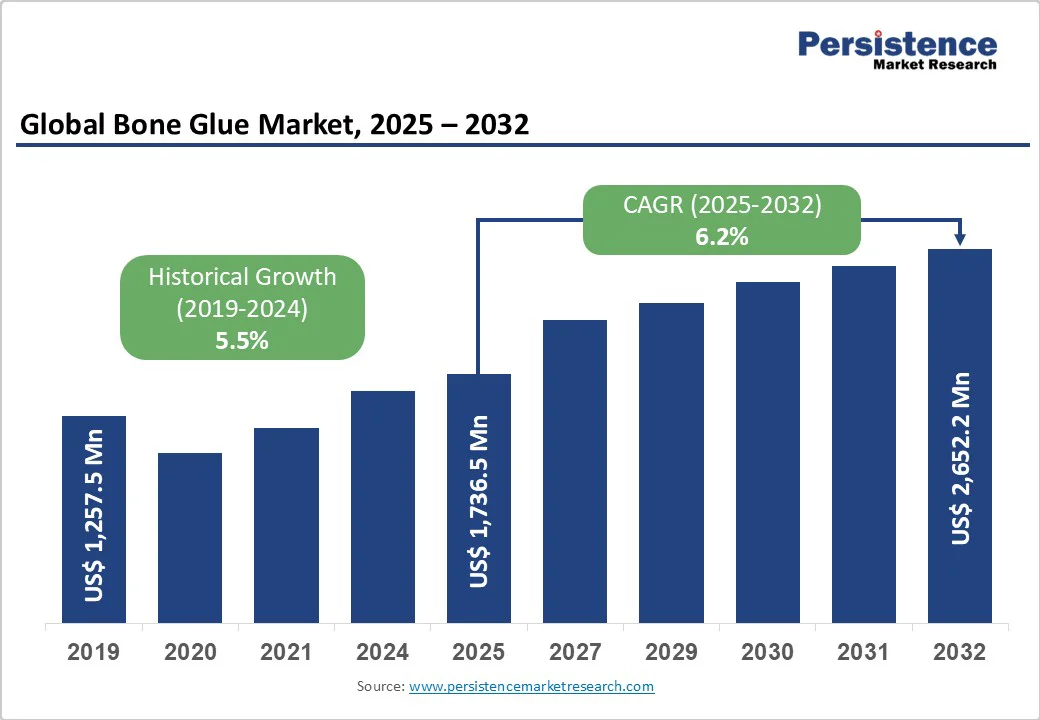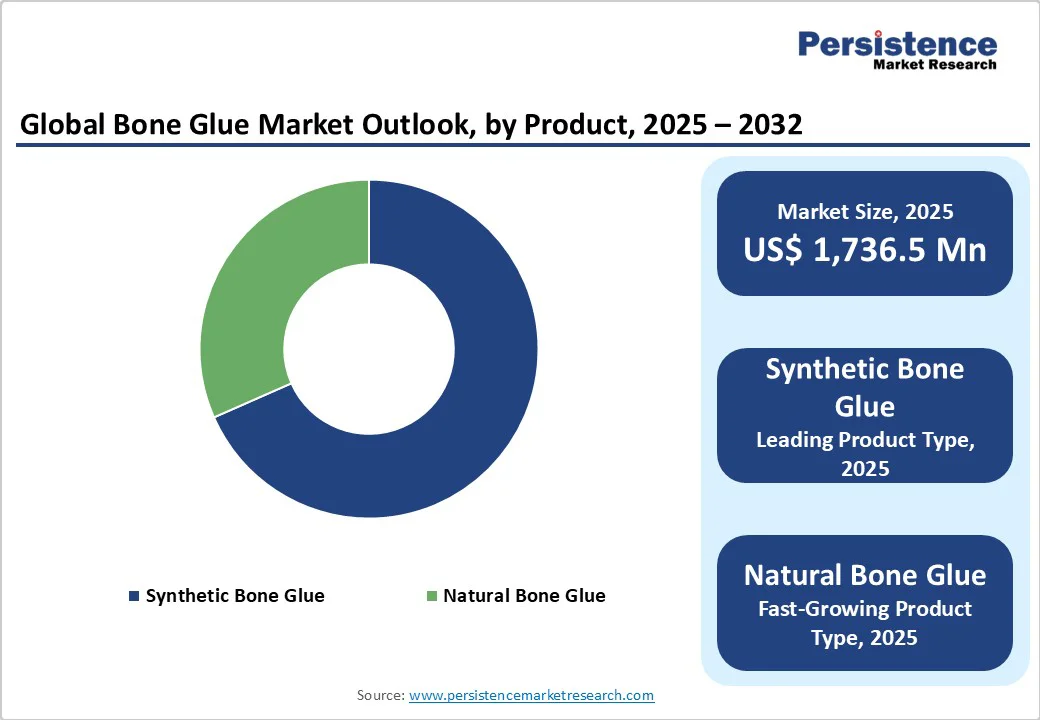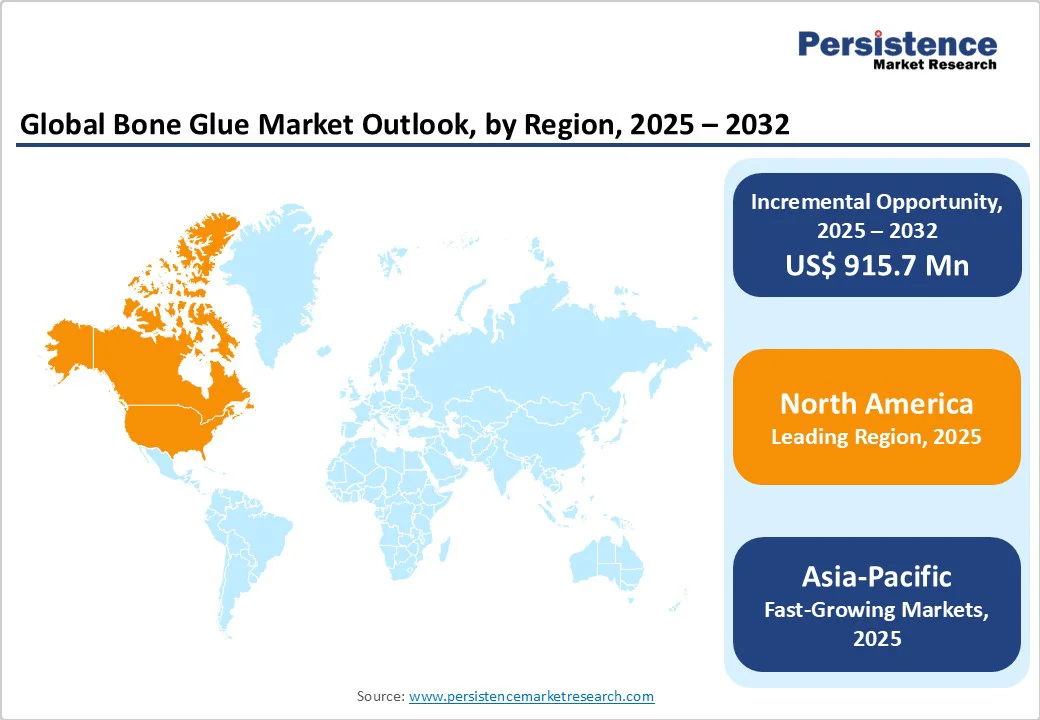ID: PMRREP3720| 185 Pages | 14 Oct 2025 | Format: PDF, Excel, PPT* | Healthcare

The global bone glue market size is likely to be valued at US$ 1,736.5 million in 2025 and is projected to reach US$ 2,652.2 million by 2032, growing at a CAGR of 6.2% during the forecast period from 2025 to 2032.
Global demand for bone glue is rising as the orthopedic, dental, and surgical sectors expand their procedures and treatments requiring advanced bone adhesives.
Increasing awareness of post-surgical recovery, the need for reliable bone fixation, and the growing adoption of synthetic and high-performance bone glues drives demand.
| Key Insights | Details |
|---|---|
| Bone Glue Market Size (2025E) | US$ 1,736.5 Mn |
| Market Value Forecast (2032F) | US$ 2,652.2 Mn |
| Projected Growth (CAGR 2025 to 2032) | 6.2% |
| Historical Market Growth (CAGR 2019 to 2024) | 5.5% |

The global burden of orthopedic conditions such as osteoporosis, osteoarthritis, and traumatic fractures is increasing, particularly among geriatric populations, which drives the global bone glue market growth. This creates demand for advanced bone repair solutions such as bone glue, which provide faster recovery and reduce the need for invasive fixation methods.
For instance, according to the International Osteoporosis Foundation, every year, around 37 million fragility fractures occur globally among people over the age of 55. Such a high fracture incidence highlights the urgent need for effective bone repair solutions to manage the rising clinical burden. Growing reliance on advanced adhesives like bone glue is expected to play a vital role in reducing recovery times and improving patient quality of life.
Advancements in biomaterial science are significantly improving the performance of bone glues, making them a stronger alternative to traditional fixation methods. New generation bioadhesives are designed to offer superior bonding even in wet physiological environments, addressing a major limitation of earlier products.
Biodegradable formulations are gaining traction, as they naturally resorb into the body without requiring secondary procedures for removal. Additionally, enhanced mechanical strength and flexibility ensure that bone glues can withstand complex load-bearing conditions, thereby expanding their use across orthopedic, dental, spinal, and trauma surgeries. These innovations are not only improving clinical outcomes but also reducing surgical times and associated healthcare costs.
High costs and reimbursement challenges remain a significant barrier to the widespread adoption of bone glue. The development of advanced formulations, particularly bioactive and biodegradable adhesives require extensive R&D investments, clinical trials, and compliance with stringent regulatory standards, all of which add to the final product price.
In many healthcare systems, especially in developing regions, limited insurance coverage and weak reimbursement frameworks make these products less accessible to both hospitals and patients. These pricing pressures not only restrict adoption but also slow down the pace of innovation and market penetration for next-generation bone adhesives.
Expanding applications present strong opportunities for the bone glue market beyond conventional orthopedic surgeries. In dental and craniofacial repair, bone adhesives are increasingly being explored for their ability to provide precise fixation in delicate anatomical areas where screws and plates may be less effective or cosmetically undesirable.
Trauma clinics and sports medicine represent another growth avenue, as bone glue offers faster stabilization of fractures and microfractures, enabling quicker recovery times for athletes and accident patients. For instance, in March 2025, RevBio obtained regulatory and ethics committee approvals across several European countries to initiate its pivotal clinical trial for a dental implant stabilization product. TETRANITE, which enables immediate implant placement in cases where traditional mechanical stability cannot be achieved. The study has already enrolled 30 of the planned 75 patients and is designed to support CE Marking for its injectable bone-adhesive technology.
Mergers and acquisitions among key players are creating significant opportunities in the market by accelerating innovation, expanding product portfolios, and strengthening global distribution networks. Large medical device companies are increasingly acquiring startups and niche firms specializing in bioadhesives to gain access to novel technologies such as biodegradable and bioactive bone glues.
These strategic deals not only provide smaller innovators with the financial resources and regulatory expertise needed to commercialize their products faster but also allow established players to diversify into high-growth segments. For instance, in December 2024, H.B. Fuller signed an acquisition agreement for two prominent medical adhesive technology firms, GEM S.r.l. and Medifill Ltd., integrating them into H.B. Fuller’s Hygiene, Health & Consumable (HHC) Adhesives Global Business Unit.
The synthetic bone glue segment is projected to lead the global bone glue market with 68.4% in 2025. The segment’s strong performance is primarily driven by its superior mechanical strength, faster setting time, and consistent quality compared to natural alternatives.
Additionally, its widespread adoption in orthopedic, dental, and spinal surgeries, coupled with increasing R&D investments by key players to enhance biocompatibility and adhesive performance, has fueled its market dominance. Hospitals and surgical centers prefer synthetic variants for reliable outcomes and ease of use.
The Arthroplasty segment is expected to dominate the global bone glue market in 2025 with a revenue share of 34.1%. Rising number of minimally invasive joint replacement surgeries, especially hip and knee arthroplasties, fueled by the increasing prevalence of osteoarthritis, osteoporosis, and other degenerative bone conditions drive the market growth.
Additionally, the adoption of minimally invasive surgical techniques and advanced bone adhesives that enhance implant stability, reduce operative time, and support faster patient recovery further boost demand in this segment.
The hospitals segment is projected to hold 48.2% of the global bone glue market in 2025. This is due to the high volume of surgical procedures performed in hospital settings, including orthopedic, dental, and spinal surgeries, which require reliable and high-quality bone adhesives.
Hospitals also have better access to advanced synthetic bone glues, trained surgical staff, and stringent protocols that ensure optimal outcomes, driving consistent demand. Moreover, the increasing number of hospital-based surgeries and investments in modern surgical infrastructure further boost the segment’s growth.

North America is expected to dominate globally with a value share of 39.5% in the 2025, with the U.S. leading the region. This dominance is due to several factors such as high prevalence of orthopedic procedures, including joint replacements and spinal surgeries, along with advanced dental surgeries, which drive steady demand for bone adhesives.
For instance, in 2024, according to the American Spine Registry, 1,112,025 spine surgery procedures were performed in the U.S. alone, highlighting the significant demand for surgical interventions that require effective bone stabilization. This large volume of procedures drives the need for bone glue products, as they are increasingly used to enhance bone fixation, improve implant stability, and support faster post-operative recovery.
The region’s well-established healthcare infrastructure supports the adoption of synthetic bone glues that improve surgical outcomes and reduce recovery time. Investments in research and development by key market players are introducing advanced adhesives with better biocompatibility, faster setting times, and stronger bonding.
Supportive reimbursement policies for surgical procedures also encourage adoption by reducing cost barriers. In addition, growing awareness of post-surgical recovery solutions and an increasing geriatric population prone to bone-related disorders further contribute to the demand for bone glue products in North America.
Europe market is projected to experience steady growth, supported by a rising number of orthopedic and dental procedures and an increasing prevalence of bone-related conditions such as osteoporosis and fractures. For instance, in 2024, according to Versus Arthritis in The State of Musculoskeletal Health 2024, more than 3,000,000 people in the UK are estimated to have osteoporosis.
This high prevalence of bone-related disorders is a key factor driving the adoption of bone glue in orthopedic procedures across Europe, as surgeons increasingly rely on advanced adhesives to support bone repair and improve surgical outcomes.
Growing awareness among healthcare professionals and patients regarding advanced surgical adhesives also contributes to market expansion. The region’s established healthcare systems, government initiatives promoting medical innovation, and ongoing research and development to enhance the safety and effectiveness of synthetic bone glues further support growth.
Additionally, the adoption of minimally invasive surgical techniques and the expansion of hospital and surgical capacities in countries such as Germany, France, and the UK help maintain consistent demand for bone glue products.
Asia Pacific is expected to register a relatively higher CAGR of around 8.2% between 2025 and 2032, driven by the rising prevalence of bone-related disorders and expanding healthcare infrastructure in countries such as China, India, and Japan. Factors such as rapid urbanization, increasing awareness of advanced surgical adhesives, and government initiatives to improve access to quality healthcare further boost market growth.
For instance, according to the Department of Science and Technology, researchers in India led a two-year project (2023 - 2025) to create an osteo-adhesive composition combining biocompatible polymers and nano-hydroxyapatite to promote bone repair.
Funded by the Government of India (Anusandhan National Research Foundation (ANRF)/Science and Engineering Research Board (SERB)), the project supports the development of strong, metal-free fixation solutions for orthopedic and craniofacial surgeries.
Additionally, growing investments in R&D by key players and governments are enhancing the adoption of bone glue in the region. For instance, in September 2025, Chinese researchers developed a biomimetic adhesive called Bone-02, inspired by oysters’ ability to adhere underwater.
This adhesive can bond shattered bone fragments within 2-3 minutes using a single injection, even in blood-rich environments. Tested in over 150 patients, it demonstrates strong mechanical strength, is biodegradable, and eliminates the need for metal implants and subsequent removal surgeries.
Such innovations are driving the Asia Pacific market, highlighting the region’s potential for rapid adoption of advanced, metal-free bone repair solutions.

The global bone glue market is highly competitive, with major players such as Artivion Inc, Baxter International Inc., RevBio, Inc., and H.B. Fuller Company dominating the market through strong product portfolios, extensive distribution networks, and continuous innovation in bone adhesive technologies.
These companies focus on developing advanced synthetic and natural bone glues with improved biocompatibility, faster setting times, and superior mechanical strength. Strategic initiatives such as mergers & acquisitions, capacity expansions, partnerships with hospitals and surgical centers, and R&D investments to enhance product performance further strengthen their market presence and drive growth in the market.
The global market is projected to be valued at US$ 1,736.5 Mn in 2025.
Rising number of orthopedic, dental, and spinal surgeries, supported by advanced synthetic adhesives with improved biocompatibility and strength drive the global market.
The global market is poised to witness a CAGR of 6.2% between 2025 and 2032.
Rising healthcare infrastructure, increasing procedures volume, and growing investments in advanced bone adhesive technologies present significant growth opportunities for the market.
Artivion, Inc., Baxter International Inc., RevBio, Inc., H.B. Fuller Company, and PBC BioMed, are some of the key players in the market.
| Report Attributes | Details |
|---|---|
| Historical Data/Actuals | 2019 - 2024 |
| Forecast Period | 2025 - 2032 |
| Market Analysis | Value: US$ Mn and Volume (if Available) |
| Geographical Coverage |
|
| Segmental Coverage |
|
| Competitive Analysis |
|
| Report Highlights |
|
By Product
By Application
By End User
By Region
Delivery Timelines
For more information on this report and its delivery timelines please get in touch with our sales team.
About Author